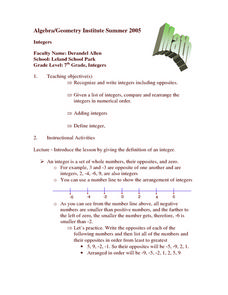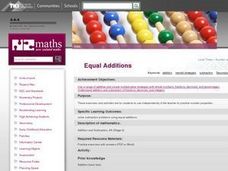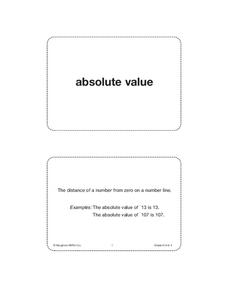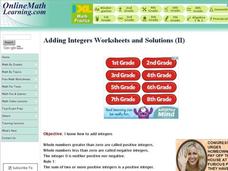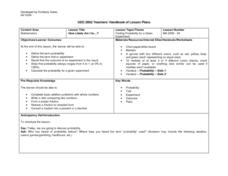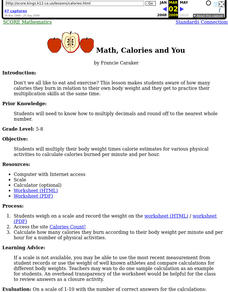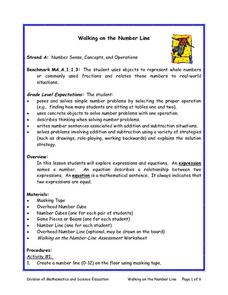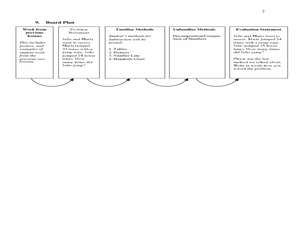Curated OER
Mathematical Properties for Addition
In this math worksheet, students read about and learn the properties of addition. Students study the commutative, associative, identity and inverse properties. There are no problems on this page for students to solve.
Curated OER
Integer
Seventh graders examine the characteristics of an integer. As a class, they observe a number line and recognize opposite numbers. Algebra tiles, or counters, are used to explore the concept of adding integers. In groups, 7th graders play...
Curated OER
Equal Additions
Students explore the relationships between numbers through the use of "equal addition" and "equal subtraction." Through the use of number sense, they are able to computer addition and subtraction problems mentally. Individually,...
Curated OER
2 digit subtraction
Second graders subtract numbers 0 through 10 from 2 digit numbers using different subtraction methods. In this subtraction lesson plan, 2nd graders practice crossing out numbers in a number line, using a 10, and using their fingers to...
Curated OER
Fraction Conversion 2 (With Percents)
Fifth graders determine how to convert fractions, decimals, and percents. In this conversion lesson, 5th graders use an on-line applet to practice making these conversions. They review how to make the conversions in a whole class lesson...
Curated OER
Add and Subtract Decimal Ten Thousandths (J)
In this addition and subtraction worksheet, students find the sums of whole numbers with decimals in the ten thousandths place value. Students solve 32 problems.
Houghton Mifflin Harcourt
Unit 4 Math Vocabulary Cards (Grade 6)
Reinforce math vocabulary with a set of flash cards. Forty-eight cards offer boldly printed words, and their corresponding definition alongside an example with labels. Terms include absolute value, inverse operations, slope, and more!
Curated OER
Adding Integers
In this integer worksheet, students solve 12 problems, adding integers. Answers and hints are available on-line; a reference web site for additional resources is given.
Curated OER
Adding Integers II
In this adding integers worksheet, students solve 10 problems, adding integers. Students may click on hint or check answer buttons. Page has links to additional resources.
Curated OER
Five Little Monkeys
Learners listen to story Five Little Monkeys Jumping On The Bed, and act out subtraction situations.
Curated OER
Probability: How Likely Am I to...?
Twelfth graders examine various ways probability is applied to daily situations. They use marbles and blocks to calculate the probabilities of picking certain colors. They also calculate the odds of picking a winning raffle ticket.
Curated OER
Math Jeopardy
Students write questions for a Jeopardy game. In this integer review lesson, students review integers by navigating through a linked web site. They play a Jeopardy game. Students create five questions, one for each of the assigned...
Curated OER
Order of Operations
Learn the rules for the order of operations with an electronic worksheet. Learners evaluate whole-number expressions and translate a word problem into an arithmetic expression. The resource includes several examples for each rule.
Curated OER
Adding Integers
Pupils add integers using a number line. In this algebra lesson, students add one and two digit integers. They compare zero pairs and the addition of integers.
Curated OER
Math in English Skills VIII Exercise Book
For some learners, fractions are the bane of fifth- and sixth-grade existence. Use this fantastic packet to help those in remediation for mathematics. The packet contains 20 worksheets with answer keys, and covers adding, subtracting,...
Curated OER
Multiplication Of Decimal Fractions
In this multiplication of decimal fractions worksheet, 8th graders use the whole number multiplication fact given to work out the answers to three word problems. Students, in addition, estimate the answers to ten problems without using a...
Curated OER
Got These Properties? (Commutative in Addition/Zero in Addition and Subtraction)
Second graders examine the commutative property of addition and the property of zero in addition and subtraction. They complete an asessment worksheet to gain practice reading and working number sentences horizontally and vertically.
EngageNY
Interpreting and Computing Division of a Fraction by a Fraction—More Models
Use a unit approach in developing a fraction division strategy. The teacher leads a discussion on division containing units, resulting in a connection between the units and like denominators. Pupils develop a rule in dividing fractions...
Curated OER
Math, Calories and You
Discover the connection between calories and weight. Pupils multiply their body weight times calorie estimates for various physical activities to calculate calories burned per minute and per hour. Worksheets a well as website links are...
Curated OER
Walking On The Number Line
Students investigate the concepts of expressions and equations while defining the similarities and differences. They explore the operations by using a number line and record answers while working with the teacher. Students play the game...
Curated OER
Study Buddies: Adding Decimals
In this math worksheet, students will work with a coach to add numbers with decimals to the hundredths place. Students will follow a step-by-step process and notes are provided for the coach.
Curated OER
Mathematics Lesson Plan
Second graders study subtraction facts. In this mathematics instructional activity, 2nd graders discuss how to solve two digit subtraction problems. Students recognize that there are many different methods or strategies one can use such...
Curated OER
Cars in Garages
First graders investigate whole numbers, and how numbers are often made up of smaller numbers. They determine the underlying concepts of addition and subtraction by examining how there is a finite set of number pairs for a given number....
Curated OER
Equal Estimates- Decimals
In this decimal estimation instructional activity, learners estimate a set of addition and subtraction problems, rounding to the nearest whole number, then place each problem in the box that contains its estimated sum or difference.

